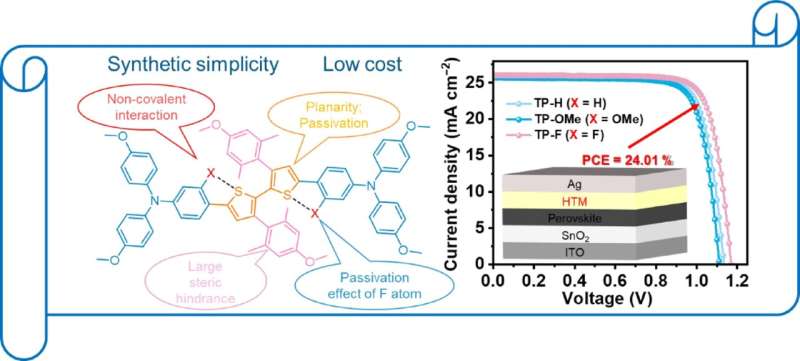This article has been reviewed according to Science X's editorial process and policies. Editors have highlighted the following attributes while ensuring the content's credibility:
fact-checked
proofread
New hole transport materials for enhancing commercial potential of perovskite solar cells

Perovskite solar cells (PSCs) are celebrated for their exceptional photovoltaic performance and affordability. However, the high cost of charge transport materials remains a major obstacle to their commercialization. Conventional materials like 2,2',7,7'-Tetrakis[N,N-di(4-methoxyphenyl)amino]-9,9'-spirobifluorene (Spiro-OMeTAD), are expensive and complex to produce.
Therefore, developing low-cost, efficient alternatives is essential to make PSCs more economically viable. Addressing these issues is crucial for advancing solar technology and achieving broader adoption. Hence, this study focuses on creating cost-effective hole transport materials to overcome these barriers and enhance the commercial potential of PSCs.
Researchers from Huaqiao University and Qufu Normal University have unveiled a pioneering advancement in the field of solar energy. Their study, published in June 2024 in the journal Energy Materials and Devices, introduces three novel hole transport materials that could redefine the efficiency of n-i-p PSCs. These materials, meticulously designed and synthesized, exhibit remarkable properties that have the potential to surpass the current benchmarks in solar cell performance, offering a promising step towards the future of renewable energy.
This study presents the development of three cost-effective hole transport materials (HTMs), 4,4'-(3,3'-bis(4-methoxy-2,6-dimethylphenyl)-[2,2'-bithiophene]-5,5'-diyl)bis(N,N-bis(4-methoxyphenyl)aniline) (TP-H), 4,4'-(3,3'-bis(4-methoxy-2,6-dimethylphenyl)-[2,2'-bithiophene]-5, 5'-diyl)bis(3-methoxy-N,N-bis(4-methoxyphenyl)aniline) (TP-OMe), and 4,4'-(3,3'-bis(4-methoxy-2,6-dimethylphenyl)-[2,2'-bithiophene]-5,5'-diyl)bis(3-fluoro-N,N-bis(4-methoxyphenyl)aniline) (TP-F), using a bithiophene core. These materials were designed to enhance molecular crystallinity and solubility, crucial for effective hole transport in PSCs.
TP-F, in particular, achieved a power conversion efficiency (PCE) exceeding 24%, attributed to its fluorine atom substitution, which enhanced intermolecular packing, lowered the highest occupied molecular orbital (HOMO) energy level, and improved hole mobility and conductivity. These improvements reduced defect states and minimized trap-mediated recombination in PSCs.
The study highlights the potential of the 3,3'-bis(4-methoxy-2,6-dimethylphenyl)-2,2'-bithiophene core structure for creating efficient, low-cost HTMs, demonstrating significant advancements in PSC technology and paving the way for more commercially viable solar energy solutions.
Dr. Wei Gao, a leading researcher in the study, stated, "The development of these novel HTMs marks a significant step towards making PSCs more commercially viable. The enhanced efficiency and reduced costs of these materials could accelerate the adoption of PSCs in the solar energy market, providing a more sustainable and cost-effective energy solution."
The implications of this research are profound, as it opens up new avenues for the commercial production of high-efficiency, low-cost PSCs. The successful integration of TP-F into PSCs demonstrates the potential for these materials to significantly reduce production costs while maintaining high performance. This advancement could lead to broader adoption of solar energy technologies, contributing to global efforts in sustainable energy development and reducing reliance on fossil fuels.
More information: Lang Li et al, Bithiophene-based cost-effective hole transport materials for efficient n–i–p perovskite solar cells, Energy Materials and Devices (2024). DOI: 10.26599/EMD.2024.9370036


















